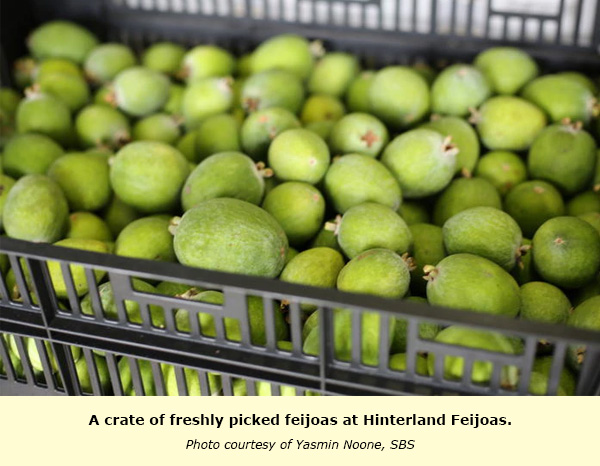The little green fruit that’s native to Brazil, feijoa, is one of the most vitamin C-rich foods you can eat. But just for the record, New Zealand discovered them before us.
“We’re going to smash feijoas,” exclaims a male New Zealander with a thick accent and irrefutable grin.

The proud Kiwi is carrying more than just an air of excitement, as he maintains a stronghold on the five-kilogram box of unusual green fruits he just bought at Hinterland Feijoas: an 11-acre feijoa farm engulfed by mountain slopes on the Sunshine Coast.
Despite momentary confusion about lingo from across the ditch and a related fear that the natural treasures may soon to be pounded and destroyed, I’m reassured that ‘smashing’ feijoas is a New Zealand expression and past-time that involves devouring the fruit en-masse.
If you haven’t seen a feijoa before, imagine a fruit resembling a lime that – once cut open – looks like a cucumber inside. Feijoas have a sweet flavour reminiscent of guava crossed with pineapple and quince. To eat a feijoa, just cut it in half horizontally and scoop out the jelly flesh as you would a kiwifruit.
Where do feijoas come from?
Even though feijoas – the fruit of the feijoa plant (feijoa sellowiana) – are native to Brazil, New Zealanders have made them their own. “We used to get feijoas by the wheelbarrow and then push it around to sell them to our neighbours,” says the feijoa fan, reminiscing about the flavours of his childhood. Now, living in Australia, he “smashes” feijoas whenever they’re in season: from March to June in the Southern Hemisphere, depending on where they are grown.
Feijoas are also a massive export industry for New Zealand. The country’s Ministry of Primary Industries recorded 54,003 kilograms of feijoa exports in 2016, compared to 20,637 exported in 2010. So if you’re not buying your feijoas fresh from one of the few farms in Australia, like Hinterland Feijoas, you may be buying a New Zealand-owned product.
Feijoas are also grown and eaten in many other South American countries, Russia, Iran, Spain and Italy.
A healthy kick of nutrients
Beyond their flavoursome reputation, feijoas are renowned worldwide because they pack such a powerful health punch.
“It’s a super high fibre fruit that’s rich in vitamin C,” says co-owner of Hinterland Feijoas and feijoa fanatic, Sally Hookey. “Feijoas also contain folic acid, so they are fantastic for pregnant women. On top of that, they’ve got potassium, magnesium and other vitamins and minerals.
“We eat masses of them and we don’t get sick of them…But if you have too many you’ll be on the toilet a lot because of the fibre,” she warns Australians, unfamiliar with the fruit. “Having only a few won’t do anything: it’s only if you eat 10 kilos [at once].”
A 2017 Brazilian study shows that feijoas are a rich source of vitamin C. In fact, the vitamin C contents of feijoa flesh are higher than those found for mango and tangerine but similar to or slightly lower than oranges, guava and papaya. The study says that just by having 100 grams of feijoas a day, Brazilians can meet their national recommended daily requirement for vitamin C.
The research also confirms the vitamin C content in the skin is higher than that in the flesh and increased in both skin and flesh after storage.
Another study led by Turkish academics, published in 2013, demonstrates that the edible feijoa peel – which maintains a slightly more bitter flavour than the flesh – is rich in antioxidants, while an Italian study from 1999 proves that various parts of the plants – leaves, fruits, seeds and stems – has antibiotic and antibacterial properties.
How do you use feijoas?
Various gourmet supermarkets and fruit stores around Australia currently sell feijoas. But once you buy them, how do you consume them?
Hookey tells SBS, feijoas are as versatile as bananas and apples. “Cook them in the same way as you would a banana or apple. If you have a recipe using either of those two fruits, just substitute [in a ratio] of one-to-one using feijoa pulp.”
The fruit can also be used in cocktails, the flowers from the tree can be steeped in hot water to make tea and the fruit’s leaves can be used to smoke food. You can freeze the pulp for use all-year-round.
On-site, Hinterland Feijoas sells jams, chutneys and balsamic vinegar made with feijoas. There’s feijoa gelato, feijoa Danish, feijoa choc-chip muffins and feijoa honey and almond cake. Hookey also makes a wicked pork and feijoa sausage roll, also sold on-site.
Even still, the passionate feijoa farmer believes the fruit tastes best when consumed as nature intended: straight off the tree.
“The health benefits make it a fantastic fresh fruit to eat,” she says. “That’s the best way to enjoy the fruit, fresh when it’s in season.”
Source: Yasmin Noone, SBS
